Three species of cottontails generally have been recorded as present in our extended area (a more northern species, Brachylagus idahoensis, was present during the late Wisconsin [the last age of the Pleistocene Epoch] in northern New Mexico, south at least to the vicinity of Albuquerque [Harris, 1993]). However, the status of several populations is in doubt (Frey, 2004).
There seems to be little doubt about the presence of Sylvilagus audubonii, S. nuttallii, and S. floridanus. However, there is considerable question as to whether or not all populations assigned in recent years to S. floridanus actually belong to that species. Ruedas (1998) resurrected S. cognatus. "It occurs primarily in the central mountains of the state (Mount Taylor, Datil, Magdalena, San Mateo, Sandia, Manzano, Capitan, and Sacramento mountains). However, there are non-montane records at the northeastern edge of its range from the Conchas River and Mesa de la Yegua in central San Miguel Co. (Bailey 1931; Hall 1981)" (Frey, 2004.
Ruedas also raised S. holzneri back to specific status. "Range limits and extent of geographic variation (including subspecies designations) are unknown. Additional taxonomic studies are warranted, It occurs in the southwestern mountains (Hidalgo, Luna, and southern Grant counties) north to the Mogollon Plateau (Bailey 1931; Hall 1981). The taxonomy of cottontails on the Mogollon Plateau that were formerly referred to S. floridanus is uncertain" (Frey, 2004.
Nuttall's Cottontail (Sylvilagus nuttallii), also known as Mountain Cottontail, is a rabbit of the pinyon-juniper woodlands (and above) of northern New Mexico. Cottontails identified as this taxon was widespread to the south during the late Wisconsin (Harris, 1993). It is predominantly a Great Basin form overlapping into adjacent geographic areas.
Traditionally, its niche has been considered as taken by the Eastern Cottontail (S. floridanus) farther south in the mountains of central and southern New Mexico. If S. cognatus and/or S. holzneri are valid, then instead it would be these species replacing it. Brushy areas near non-wooded openings seem preferred; in southwestern New Mexico, S. floridanus (or S. holzneri) descends into more open pinyon-juniper-oak woodlands. The Eastern Cottontail also occurs in the lusher grasslands of the Great Plains in eastern New Mexico. Farther afield, it covers the region from the Great Plains to the East Coast and from near the Canadian border south well into Central America.
Lowland areas surrounding the habitats of these upland species are inhabited by the Desert Cottontail (Sylvilagus audubonii), which at times extends up into open woodland. It extends from the western Great Plains through the southern Great Basin and south into southern Mexico.
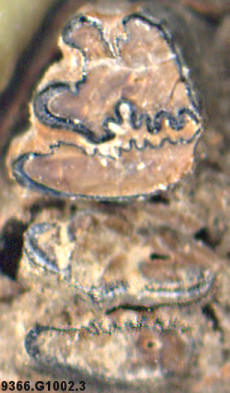 Cottontails are difficult to identify. The lower p3 often
discriminates among regional species, though under the five-species hypothesis, this may break down. The p3 of the Desert Cottontail is the most distinctive of the New Mexico species. The strong
crinkling seen in Fig. 1 is typical as is the relatively deep anterior reentrant and the slightly constricted, long loph lateral to it. The strong crinkling also occurs on the posterior side of the
lateral reentrant in p4 through m2 and can be seen in p4 in the figure.
Cottontails are difficult to identify. The lower p3 often
discriminates among regional species, though under the five-species hypothesis, this may break down. The p3 of the Desert Cottontail is the most distinctive of the New Mexico species. The strong
crinkling seen in Fig. 1 is typical as is the relatively deep anterior reentrant and the slightly constricted, long loph lateral to it. The strong crinkling also occurs on the posterior side of the
lateral reentrant in p4 through m2 and can be seen in p4 in the figure.
Fig. 1. Left p3 and p4 of a fossil Desert Cottontail (Sylvilagus audubonii). The enamel has fossilized dark, the dentine medium brown, and the cement lighter brown.
Auditory bullar size frequently correlates with the average relative humidity of the habitat in various North American mammals. Size among the cottontails is largest in the Desert Cottontail, smaller in the Mountain Cottontail, and smallest in the Eastern Cottontail.
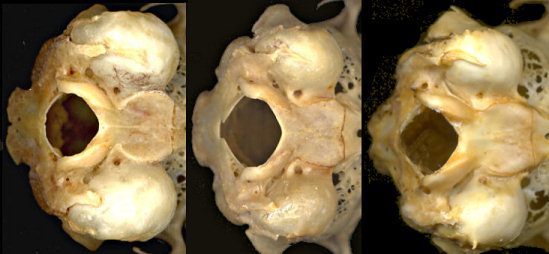
Fig. 2. Relative sizes of the auditory bullae of three species of Sylvilagus: from left to right, S. audubonii, S. nuttallii, and S. floridanus. The latter is from Luna Co., NM, and presumably would represent S. holzneri if that is a good species.
Also note in Fig. 2 that the constriction of the basioccipital of S. audubonii is much stronger than in the other two species; a ratio of bullar width to basioccipital constriction will separate S. audubonii from the other species.
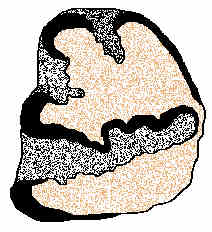
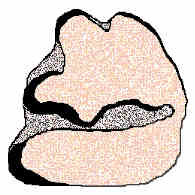
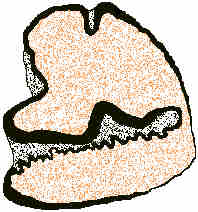
Fig. 3. Drawings of the left p3s of three species of Sylvilagus; from left to right, S. audubonii, S. nuttallii and S. floridanus/cognatus. Enamel, black; dentine, stippled red; cement, stippled black.
Although insufficient to capture the variability of p3s, the three drawings show tendencies of the three species. The Desert Cottontail seems always to display strong enamel crinkling. The Mountain Cottontail seldom has any crinkling of the posterior wall of the medial lateral reentrant. The "floridanus-types" usually have some crinkling. The extension lateral to the anterior reentrant usually is wider in the latter species than in S. audubonii.
Last Update: 14 Feb 2008
Centennial Museum and Department of Biological Sciences, The University of Texas at El Paso